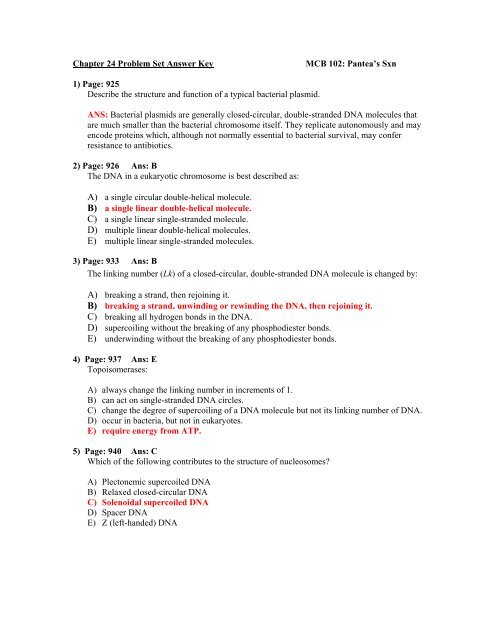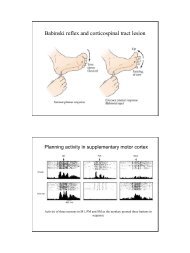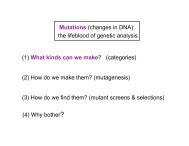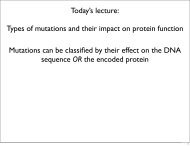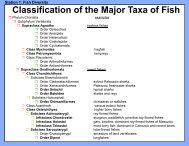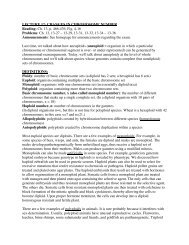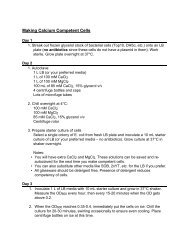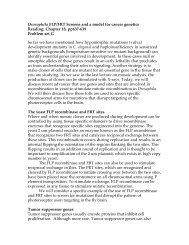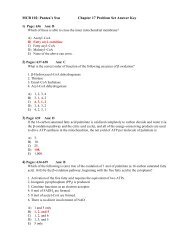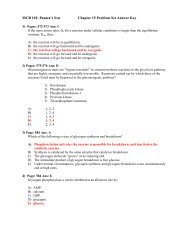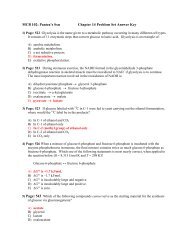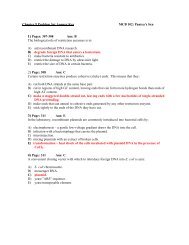Ch 24 Problem Set Answer Key
Ch 24 Problem Set Answer Key
Ch 24 Problem Set Answer Key
You also want an ePaper? Increase the reach of your titles
YUMPU automatically turns print PDFs into web optimized ePapers that Google loves.
<strong>Ch</strong>apter <strong>24</strong> <strong>Problem</strong> <strong>Set</strong> <strong>Answer</strong> <strong>Key</strong> MCB 102: Pantea’s Sxn<br />
1) Page: 925<br />
Describe the structure and function of a typical bacterial plasmid.<br />
ANS: Bacterial plasmids are generally closed-circular, double-stranded DNA molecules that<br />
are much smaller than the bacterial chromosome itself. They replicate autonomously and may<br />
encode proteins which, although not normally essential to bacterial survival, may confer<br />
resistance to antibiotics.<br />
2) Page: 926 Ans: B<br />
The DNA in a eukaryotic chromosome is best described as:<br />
A) a single circular double-helical molecule.<br />
B) a single linear double-helical molecule.<br />
C) a single linear single-stranded molecule.<br />
D) multiple linear double-helical molecules.<br />
E) multiple linear single-stranded molecules.<br />
3) Page: 933 Ans: B<br />
The linking number (Lk) of a closed-circular, double-stranded DNA molecule is changed by:<br />
4)<br />
A) breaking a strand, then rejoining it.<br />
B) breaking a strand, unwinding or rewinding<br />
the DNA, then rejoining it.<br />
C) breaking all hydrogen bonds in the DNA.<br />
D) supercoiling without the breaking of any phosphodiester bonds.<br />
E) underwinding without the breaking of any phosphodiester bonds.<br />
Page: 937 Ans: E<br />
opoisomerases:<br />
T<br />
A) always change the linking number in increments of 1.<br />
B) can act on single-stranded DNA circles.<br />
C) change the degree of supercoiling of a DNA molecule but not its linking number of DNA.<br />
D) occur in bacteria, but not in eukaryotes.<br />
E) require energy from ATP.<br />
5) Page: 940 Ans: C<br />
hich of the following contributes to the structure of nucleosomes?<br />
W<br />
A) Plectonemic supercoiled DNA<br />
B) Relaxed closed-circular DNA<br />
C) Solenoidal supercoiled<br />
DNA<br />
D) Spacer DNA<br />
E) Z (left-handed) DNA
6) Pages: 933-935, 940<br />
Indicate whether the following statements are true (T) or false (F).<br />
___ The linking number (Lk) of a closed-circular DNA molecule can be changed only<br />
by breaking one or both strands.<br />
___ DNA of all organisms is overwound (i.e., positively supercoiled).<br />
___ Topoisomerase I relaxes DNA that is highly negatively supercoiled.<br />
___ In a nucleosome, eukaryotic DNA is wrapped around histone proteins.<br />
ANS: T; F; T; T<br />
7) Pages: 939-941<br />
What are histones and what is their principal role in chromatin structure?<br />
ANS: Histones are small basic proteins that bind to DNA. There are five main types, four of<br />
which interact with each other to form the core of the nucleosome around which the DNA is<br />
wrapped. The fifth (H1) is believed to be involved in compaction of nucleosomes to form a<br />
higher-order structure.


